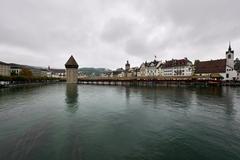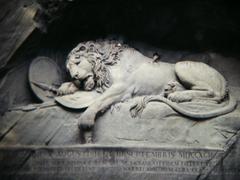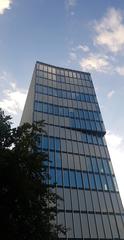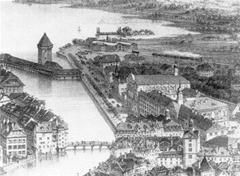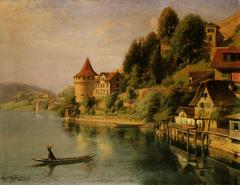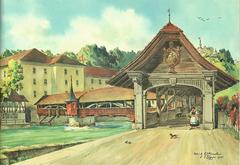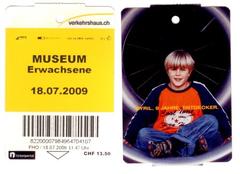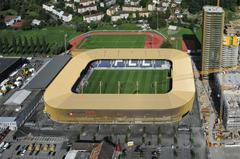Pulverturm Lucerne Visiting Hours, Tickets, and Travel Guide
Date: 14/06/2025
Introduction to Pulverturm Lucerne and Its Historical Significance
The Pulverturm, or Gunpowder Tower, is a prominent feature of Lucerne’s medieval Musegg Wall and stands as a testament to the city’s rich historical legacy and defensive ingenuity. Dating from the late 14th or early 15th century, the Pulverturm was purpose-built to store gunpowder and munitions, reflecting Lucerne’s strategic priorities during a transformative era in Swiss history (Museggmauer Luzern). As one of the nine remaining towers of the original fortifications, it provides visitors with insight into medieval urban planning and military architecture.
While the tower’s interior is typically closed to the public for preservation and safety, its imposing exterior along the Musegg Wall remains accessible throughout the year. The Pulverturm’s austere stonework and strategic location are reminders of its original defensive function. Its ongoing maintenance by the Wey-Zunft guild ensures that the tower remains a living symbol of Lucerne’s communal and cultural identity (Wey-Zunft Luzern). Visitors can explore the Musegg Wall from early April to late October without admission fees, often combining their visit with nearby highlights such as the Chapel Bridge and the Lion Monument (Luzern.com). Guided tours offer deeper historical context, though visitors should note that the historic terrain limits wheelchair accessibility.
This guide provides essential information on Pulverturm’s visiting hours, access, ticket policies, and cultural significance, ensuring an enriching experience for travelers and history enthusiasts alike. For those unable to visit in person, official websites offer virtual tours and galleries, while local festivals like Lucerne Carnival highlight the Pulverturm’s role as a vibrant component of the city’s heritage (Museggmauer Pulverturm).
Table of Contents
- Discover the Pulverturm Lucerne: Your Complete Visitor’s Guide
- Origins and Historical Context
- Function and Historical Use
- Architectural Features
- Visiting the Pulverturm Lucerne: Hours, Tickets, and Accessibility
- Restoration, Modern Use, and Cultural Significance
- Exploring the Musegg Wall and Nearby Attractions
- Visuals and Virtual Tours
- Frequently Asked Questions (FAQs)
- Practical Visitor Information
- References and Further Reading
Discover the Pulverturm Lucerne: Your Complete Visitor’s Guide
Set within Lucerne’s iconic Musegg Wall, the Pulverturm is a striking reminder of the city’s medieval defenses and architectural prowess. As one of the most evocative structures in Lucerne, it offers history buffs and curious travelers a unique window into the past. This guide compiles all the practical details you need for your visit, from opening hours to local travel tips.
Origins and Historical Context
The Pulverturm is among the oldest towers of the Musegg Wall, constructed during a time when Lucerne was rapidly expanding and fortifying itself amidst rising trade and military advances (Museggmauer Luzern). While the Musegg Wall once boasted over 40 towers and gates, only nine remain today, with the Pulverturm dating from the city’s major fortification phase in the late 14th to early 15th centuries (Lucerne History).
Function and Historical Use
Named for its primary function as a gunpowder magazine, the Pulverturm was central to Lucerne’s defenses. After the 1701 explosion at the Heuturm, the Pulverturm’s role as a backup storage for gunpowder became even more critical (Museggmauer Luzern). With its thick walls and vantage point, the tower also served as a lookout and, occasionally, as a prison (Museggmauer Pulverturm).
Architectural Features
Exterior Structure
The Pulverturm stands about 27.5 meters tall, making it one of the tallest on the Musegg Wall (Museggmauer Luzern). Its robust stone construction, narrow loopholes, and visible transitions in masonry indicate phased building during the Middle Ages (Museggmauer Pulverturm).
Interior Layout
Historical records describe multiple levels inside: secure storage on the lower floors and guard quarters above, all protected by heavy wooden doors and iron fittings. Due to safety concerns, the interior remains closed except during special events or by arrangement with the Wey-Zunft (Wey-Zunft Luzern).
Roof and Symbolism
The steep, tiled roof is typical of Lucerne’s towers, efficiently shedding precipitation and forming a distinctive part of the city skyline. The Pulverturm’s silhouette is a visible symbol of Lucerne’s martial heritage (Museggmauer Luzern).
Visiting the Pulverturm Lucerne: Hours, Tickets, and Accessibility
Visiting Hours and Ticket Information
- Exterior Access: Year-round; the tower can be admired from the outside at any time.
- Musegg Wall Access: Open from early April to late October (typically 8:00–19:00).
- Interior Access: Pulverturm is not open for general public entry. Special access is possible during events or by prior arrangement with the Wey-Zunft (Wey-Zunft Luzern).
- Tickets: No tickets required for the wall or exterior views. Guided tours may have separate fees (Luzern.com).
Accessibility
Due to its medieval construction and uneven terrain, the Pulverturm and Musegg Wall have limited wheelchair and pram access. Visitors with mobility concerns should seek assistance at the Lucerne Tourist Information Center.
Best Times to Visit and Travel Tips
- Best Seasons: Spring and autumn (April–October) for pleasant weather and fewer crowds.
- Photo Opportunities: Early morning and late afternoon for the best lighting.
- Nearby Landmarks: Combine your visit with the Chapel Bridge, Lion Monument, and Old Town squares.
- Weather: Lucerne weather can be unpredictable—bring layers and rain protection.
Restoration, Modern Use, and Cultural Significance
Since 1979, the Pulverturm has been under the stewardship of the Wey-Zunft, who have restored its interior for guild functions and social gatherings (Wey-Zunft Luzern). The tower is a living monument, frequently featured in local celebrations such as the Lucerne Carnival, where its historical role is reflected in festivities like the “Urknall” cannon shot (Hotel Sempachersee). The Pulverturm also supports rare wildlife, with kestrels, bats, and unique plants finding refuge on the Musegg Wall (Simskultur).
Exploring the Musegg Wall and Nearby Attractions
The Pulverturm is part of a nearly 900-meter-long wall with nine surviving towers, one of Switzerland’s best-preserved medieval fortifications (Museggmauer Luzern). A walk along the Musegg Wall offers sweeping views of Lucerne, Lake Lucerne, and the Alps. Other towers—such as the Zytturm (with the city’s oldest clock)—can be entered, and interpretation panels provide historical context.
Nearby must-sees:
- Chapel Bridge (Kapellbrücke): Famous for its covered walkway and historic paintings.
- Lion Monument: A moving sculpture commemorating Swiss Guards.
- Old Town: Cobblestone streets, baroque churches, and vibrant squares.
Visuals and Virtual Tours
- Panoramic Views: Capture Lucerne’s skyline from vantage points along the Musegg Wall.
- Virtual Tours: Explore the Pulverturm and Musegg Wall online (Museggmauer Pulverturm).
- Photography Tip: Morning and sunset light accentuate the tower’s medieval stonework.
Frequently Asked Questions (FAQs)
Can I enter the Pulverturm?
No, interior access is closed to the public except on special occasions or by arrangement.
What are the visiting hours?
Musegg Wall is open from early April to late October, typically from 8:00–19:00.
Are tickets required?
No, exterior access is free; guided tours may charge a fee.
Is it wheelchair accessible?
Due to historic stairs and uneven terrain, accessibility is limited.
Are guided tours available?
Yes, many walking tours of Lucerne Old Town include the Pulverturm as a highlight.
Practical Visitor Information
- Location: Northern edge of Lucerne Old Town, between Schirmerturm and Allenwindenturm.
- Getting There: Easily accessible on foot; public transport links nearby.
- Travel Tips: Wear sturdy shoes; bring weather-appropriate clothing; check event calendars for special access.
- Photography and Etiquette: Respect barriers and signage; drones are not permitted.
Summary: Why Visit the Pulverturm?
The Pulverturm stands as a fusion of historical significance, architectural resilience, and living cultural tradition. While its interior remains closed, the tower’s exterior, dramatic location, and role in Lucerne’s festivals and heritage make it a must-see for visitors. Plan your visit during the open season, combine it with a stroll along the Musegg Wall, and immerse yourself in Lucerne’s medieval story (Museggmauer Luzern; switzerlanding.com).
References and Further Reading
- Museggmauer Luzern
- Museggmauer Pulverturm Details
- Wey-Zunft Guild Pulverturm
- GPSmyCity Pulverturm Visitor Info
- Lucerne History
- Luzern.com
- switzerlanding.com
- Simskultur
- Hotel Sempachersee
- nomads-travel-guide.com
